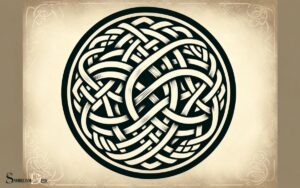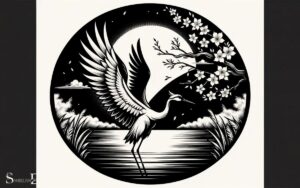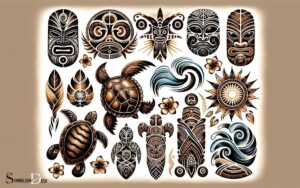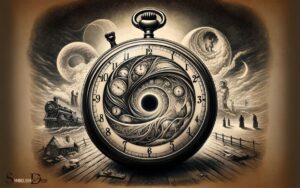Spiritual Symbols and Meanings for Tattoos: Culture!
Explore the profound significance of spiritual symbols and their meanings for tattoos, covering the history, culture, and symbolism that influence these sacred designs.
Learn about their connections to ancient traditions, Christian iconography, Eastern spirituality, and modern interpretations.
Embrace the art of tattooing as a form of universal expression through nature motifs, elemental signs, and sacred geometry.
Spiritual symbols serve as a bridge between the physical world and the metaphysical realm, offering a visual representation of deeper truths and beliefs.
In tattoo art, these symbols can vary widely, including:
- Ancient symbols: These may include the Eye of Horus, Celtic knots, or Native American totems, each with their own unique heritage and significance.
- Christian symbols: Examples include the cross, doves, or ichthys (fish symbol), which represent faith, peace, and discipleship.
- Eastern symbols: The Om symbol, lotus flower, or yin and yang are often used to express concepts like enlightenment, balance, and life cycles.
- Modern symbols: Contemporary designs may incorporate elements like the infinity symbol or modern takes on traditional motifs.
Each tattoo not only holds aesthetic appeal but also a personal and collective meaning, often rooted in storytelling, religious texts, or nature-inspired myths.
Tattoos are more than art; they are emblems of one’s inner journey and personal evolution, etched in ink.

Key Takeaway
Ancient Symbols: Uncovering the Origins
The article explores the origins of ancient symbols and their significance in spiritual tattoos.
Many ancient symbols have deep roots in various cultures and hold significant spiritual meanings. For example, the lotus flower has origins in Hinduism and Buddhism, symbolizing purity and enlightenment.
The Celtic cross, originating from the Celtic culture, represents the bridge between the divine and earthly realms.
These symbols aren’t merely decorative; they carry profound spiritual significance for those who choose to adorn their bodies with them.
Understanding the origins of these symbols provides insight into the rich tapestry of human spirituality throughout history.
Christian Icons: Symbolism and Significance
Many Christian symbols hold deep meaning and significance for those who choose to have them inked on their skin. The cross, a symbol of faith, and the dove, representing peace and purity, are popular choices for Christian-themed tattoos.
Understanding the symbolism behind these icons can help individuals make a meaningful and personal choice for their body art.
Cross: Symbol of Faith
The cross symbolizes unwavering faith for many Christians, representing the enduring significance and power of their beliefs. It serves as a reminder of Jesus Christ’s sacrifice and the core principles of Christianity, such as love, redemption, and forgiveness.
The vertical line of the cross is seen as a representation of the divine, connecting heaven and earth, while the horizontal line symbolizes the earthly realm and the material world.
This intersection signifies the unity of these two realms and the reconciliation between God and humanity.
The cross isn’t only a religious symbol but also a visual expression of hope, strength, and salvation. Many Christians choose to tattoo the cross as a permanent symbol of their faith and a personal reminder of their spiritual journey.
Dove: Peace and Purity
Doves symbolize peace and purity in Christian iconography, embodying the virtues of innocence and tranquility. They hold deep significance for those seeking spiritual symbols for tattoos.
The dove’s representation of peace and purity is rooted in biblical stories, such as the account of Noah’s Ark, where a dove returns with an olive branch, symbolizing the end of the flood and the beginning of a new era.
In Christianity, doves also represent the Holy Spirit, conveying messages of hope and divine guidance. Furthermore, the dove’s gentle nature and white feathers serve as a reminder of the purity and grace of God.
This symbolism has made the dove a popular choice for tattoos among individuals seeking to express their faith and embrace these virtues.
Moving forward, the article will delve into the influence of eastern spiritual emblems on tattoo symbolism.
Eastern Spiritual Emblems: Cultural Influences
Incorporating Eastern spiritual emblems into tattoo designs reflects a deep appreciation for the cultural influences of the East.
The symbols and meanings behind Eastern spiritual emblems are rich and varied, often rooted in ancient philosophies and religious traditions. This fusion of spirituality and art creates a powerful and meaningful tattoo experience.
Below are some Eastern spiritual emblems and their cultural significance:
| Symbol | Meaning | Cultural Influence |
|---|---|---|
| Lotus | Purity and Enlightenment | Buddhism and Hinduism |
| Dragon | Power and Strength | Chinese and Japanese folklore |
| Om | Unity and Divine Spirit | Hinduism and Buddhism |
| Koi Fish | Perseverance and Courage | Japanese and Chinese culture |
| Yin Yang | Harmony and Balance | Taoism and Confucianism |
Understanding the cultural influences behind these emblems can deepen the significance of Eastern-inspired tattoos.
Nature and Elements: Connecting With the Universe
Nature and the elements hold deep symbolism and meaning for many individuals seeking spiritual connection through tattoos.
Earth represents grounding and stability, air embodies freedom and movement, and water symbolizes intuition and flow.
These natural elements provide a powerful way for individuals to connect with the universe and express their spirituality through body art.
Earth: Grounding and Stability
One might choose to incorporate the symbol of Earth into their tattoo design for its association with grounding and stability, reflecting a deep connection with the natural elements and the universe.
The Earth symbol holds deep spiritual significance for many individuals, representing the following:
- Grounding and Stability: Earth symbols can serve as a reminder to stay rooted and balanced in the face of life’s challenges.
- Connection with Nature: It signifies a strong bond with the environment and the importance of preserving the planet.
- Strength and Endurance: The Earth is enduring and resilient, symbolizing inner strength and the ability to withstand adversity.
- Interconnectedness: It represents the interconnectedness of all living things and the universe, fostering a sense of unity and harmony.
By incorporating the Earth symbol into a tattoo, individuals can carry a constant reminder of these profound meanings.
As the Earth provides stability, the next section will focus on ‘air: freedom and movement’.
Air: Freedom and Movement
Freedom and movement symbolize the essence of air in spiritual tattoos. They embody a sense of liberation and fluidity in the individual’s connection with the universe.
Air represents freedom, allowing one to transcend physical limitations and soar to new heights. This element symbolizes the ability to embrace change and adapt to new circumstances, reflecting the ever-changing nature of life.
In spiritual tattoos, birds, feathers, or swirling patterns often depict the concept of air. These images represent the unbounded spirit and the capacity to move gracefully through life’s challenges.
The air element encourages individuals to let go of restrictions and embrace boundless opportunities. Through the depiction of air in tattoos, individuals seek to express their desire for liberation and their connection to the vast, expansive universe.
Water: Intuition and Flow
Intuitively navigating life’s currents, incorporating water symbolism into spiritual tattoos enables individuals to connect with the universe’s flowing energy.
Water represents intuition, emotions, and the subconscious mind, making it a powerful symbol for those seeking a deeper connection with the universe.
Here are four key aspects of water symbolism in spiritual tattoos:
- Intuition: Water’s ability to adapt and change mirrors the fluidity of intuition, encouraging individuals to trust their inner guidance.
- Flow: Symbolizing the natural flow of life, water reminds individuals to embrace change and go with the flow of the universe.
- Emotional Depth: Depicting the depth of emotions, water tattoos serve as a reminder to explore and understand one’s feelings.
- Cleansing and Renewal: Water’s purifying nature signifies the process of cleansing and renewal, offering a fresh start and spiritual rejuvenation.
Mythological Figures: Legends in Ink
When considering mythological figures for tattoos, one can find a rich tapestry of ancient legends and symbolism to draw inspiration from. Mythological figures have long been a popular choice for tattoos due to their deep cultural significance and timeless appeal.
From the powerful and wise symbolism of dragons in Chinese mythology to the strength and bravery embodied by the Norse god Thor, mythological figures offer a diverse range of meanings for those seeking to express themselves through body art.
Greek mythology also provides a wealth of iconic figures such as Zeus, Athena, and Poseidon, each representing different qualities and virtues.
These mythological figures can serve as personal symbols of inner strength, protection, or guidance, making them compelling choices for meaningful and visually striking tattoos.
Sacred Geometry: Symmetry and Spirituality
Sacred geometry plays a pivotal role in the world of tattoos, as it merges artistic expression with spiritual symbolism, offering individuals the opportunity to embody profound meanings through the intricate interplay of shapes and patterns.
This subtopic delves into the significance of symmetry and spirituality within sacred geometry, shedding light on its deep-rooted connections to the human experience.
Symmetry and spirituality in sacred geometry are manifested through:
- Balance: Reflecting the harmony and equilibrium within the universe.
- Unity: Symbolizing the interconnectedness of all existence.
- Transcendence: Representing the journey towards higher consciousness and enlightenment.
- Order: Signifying the structured nature of reality and the cosmos.
Modern Spiritual Symbols: Contemporary Expressions
The article explores how modern spiritual symbols are being incorporated into tattoo designs as contemporary expressions of personal beliefs and values.
In today’s diverse society, individuals are seeking new ways to represent their spirituality through tattoos. Symbols such as the lotus flower, mandalas, and the Tree of Life have gained popularity for their deep spiritual meanings and aesthetic appeal.
These symbols serve as a visual representation of the individual’s connection to higher consciousness, inner peace, and personal growth.
Additionally, modern interpretations of traditional religious symbols, such as the Om symbol or the Hamsa hand, are being creatively reimagined to reflect a more inclusive and eclectic spiritual perspective.
Sak Yant Tattoo Symbols and Meanings
Sak Yant tattoos are a form of traditional tattoo art that originated in Thailand and are also popular in Cambodia and other Southeast Asian countries.
These tattoos are typically applied by Buddhist monks or experienced tattoo artists using a long metal rod with a needle at the end.
Sak Yant tattoos are believed to offer protection, luck, and various other spiritual benefits. Each symbol or design in a Sak Yant tattoo has its own specific meaning and purpose.
Here are some common Sak Yant tattoo symbols and their meanings:
Hah Taew (Five Lines):
The Hah Taew is one of the most popular and well-known Sak Yant designs. It consists of five vertical lines of varying lengths intersected by two horizontal lines. Each line has its own meaning, which includes protection from harm, charisma, and invincibility.
Gao Yord (Nine Spires):
The Gao Yord is a sacred design representing nine peaks or spires. It is believed to offer protection from danger, harm, and evil spirits. It is often used for its powerful protective qualities.
Paed Tidt (Eight Direction Yant):
The Paed Tidt is an eight-pointed geometric design that represents the eight cardinal directions. It is associated with balance, protection, and the prevention of bad luck.
Tua Gao (Tiger Yant):
The Tiger Yant features a tiger’s face and claws. It is associated with courage, strength, and protection from danger. This design is often chosen by individuals seeking bravery and confidence.
Suea Maha Amnaj (Tiger Head Yant):
This design typically features the head of a tiger and is believed to provide protection, authority, and dominance. It is often chosen by those in positions of power or authority.
Hanuman (Monkey God):
Hanuman is a popular Hindu deity known for his strength and loyalty. A Hanuman Sak Yant is believed to offer protection, strength, and agility. It is often chosen by athletes and those seeking physical prowess.
Yant Phutson (Buddha’s Footprint):
The Yant Phutson represents the footprint of the Buddha. It symbolizes the path to enlightenment, spiritual guidance, and protection.
Yantra (Sacred Geometry):
Yantra designs are intricate geometric patterns that hold specific meanings and magical properties. They can vary widely in symbolism and are chosen based on the individual’s needs and desires.
Gao Yord Nam Oi (Nine Peaks with Water Drop):
Similar to the Gao Yord, this design incorporates a water drop at the center. It is believed to provide protection and enhance one’s charm and attractiveness.
Prajao Sip (Ten Crowns):
The Prajao Sip is a design featuring ten crowns, often associated with leadership, authority, and success. It is believed to bring power and influence to the wearer.
It’s important to note that Sak Yant tattoos are deeply rooted in cultural and spiritual traditions, and the process of getting one involves rituals and ceremonies performed by a monk or experienced practitioner.
These tattoos are considered sacred, and it’s essential to show respect and understanding of their cultural significance when seeking one.
Additionally, the specific meanings and interpretations of Sak Yant symbols may vary slightly depending on the individual monk or practitioner performing the tattoo.
Conclusion
Tattoos are a powerful way to express one’s spiritual beliefs and values. From ancient symbols to modern expressions, each design holds deep meaning and significance. Tattoos can serve as a personal reminder of one’s inner journey, acting as a visual commitment to spiritual growth or a connection to something greater. For many, the placement of the tattoo also carries importance, with hand tattoos often being the most visible and intentional choice. With hand tattoo symbols explained, individuals can better appreciate the depth of their own designs and the cultural or spiritual stories they convey.
As the old saying goes, ‘A picture is worth a thousand words,’ and these spiritual symbols speak volumes about the wearer’s connection to the divine and the universe.
So next time you see someone with a spiritual tattoo, remember that it’s a visual representation of their inner journey and faith.






